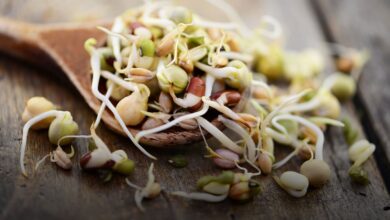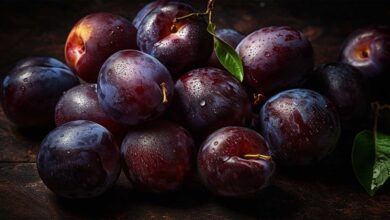Varieties, nutritional qualities and recipes

A beautiful, orange-hued fruit that's perfect for sweetening the winter, the persimmon is a fruit of Asian origin that is still relatively unknown. It grows more precisely in China, where there are more than 800 different species. Traditionally, it is enjoyed on Chinese New Year for its highly regarded flavor and benefits.
Since the nineteenth century, it has been exported to other continents. It adapts easily to tropical climates. Some of its varieties are even grown in the south of France.
Its varieties
These autumn fruits appear on our stands from October and can decorate our baskets until the beginning of winter. In France, about a hundred species are available. Each has very distinct sensory qualities and culinary uses. To facilitate the correct choice, two families of persimmons are distinguished: astringent and non-astringent persimmons.
Soft, dark red flesh
These are astringent persimmons, rich in tannins, which may be responsible for this biomechanical sensation on the tongue. It is initially unpleasant in the mouth, but can make digestion more difficult. Therefore, it is preferable to choose them that are dark in color (almost brown) and eat them very ripe when their flesh is creamy, like flan. It can even be eaten with a teaspoon. It tastes naturally sweet, smooth on the palate, like the taste of honey. It is recommended to eat it without the skin to get rid of some of its astringent components. It is best to eat it directly, on the same day, or keep it in the refrigerator before eating it the next day, for example.
To identify these types of persimmons, labels can help, indicating the following names: persimmon, topate, or even hachia… Visually, their shape is slightly more elongated than other types.
With firm orange flesh
Like an apple, it can be chewed as is, and washed carefully beforehand. It is finely chopped with a knife to make beautiful slices. The non-astringent flesh of a persimmon can also become soft as it ripens, but not as much as the flesh of a topati or persimmon. Its sweet flavor is reminiscent of apricot or mango, with a slight nutty aftertaste. Some even give it a vanilla note.
Here are some examples that can be easily noticed on our shelves: Sharon, Fuyu, Geumbo… Less fragile than the astringent persimmons, these varieties keep very well outdoors or in cold weather for a whole week. Round in shape, sometimes a little flat, the ideal is to choose it smooth and very firm. The skin and stem must be intact and handled with care.
Its nutritional qualities
Persimmon contains many essential nutrients that contribute to the proper functioning of the body. A healthy fruit rich in carbohydrates, vitamins and minerals and has its place as part of a balanced diet:
- There are more than 15 grams of carbohydrates per 100 grams of persimmon, making it one of the sweetest fruits. That is, about 70 calories per 100 grams. The composition of polysaccharides is a perfect combination of glucose and fructose. It provides energy, has little protein, and contains no fat, like most plants.
- Rich in fibre, at 3g per 100g, it helps promote healthy intestinal transit and provides good satiety. It consists of pectin, which is responsible for the elasticity of the fruit. The riper the persimmon, the richer it is in pectin and carbohydrates. On the contrary, the lower the number of tannins.
- Color pigments: lycopene, carotenoids and xanthin. They are the origin of its beautiful orange color. In fact, persimmon is one of the fruits richest in provitamin A (1.4 mg per 100 grams). It is also considered a good source of vitamin C, the content of which varies according to its maturity.
- Concentrate of antioxidants: flavonoids, tannins, vitamin A, vitamin C, vitamin E, carotenoids. Persimmon is a true ally in the fight against oxidative stress and cell aging. Its antioxidants help maintain eye and skin health.
- Its minerals are also important. The main elements it provides are potassium, calcium and phosphorus. It is highly regarded by athletes, before or after training, to boost energy and muscle recovery.
Persimmons have many beneficial nutritional benefits to strengthen the immune system, reduce inflammation, and take care of blood pressure and the cardiovascular system. Its leaves are also used to combat diabetes and prevent its complications.
Image rights © Adobe Stock
How to cook persimmon?
In its simplest form, it can be enjoyed like fresh fruit. In a salad seasonal fruits, chopped, go great with kiwi, pear or pomegranate for example.
There are many possible recipes for the dessert. Ripe, soft-fleshed persimmons are served in a cup, enhancing the chia pudding. Simply replace the mango with the classic version, and add a pinch of grated coconut.
In crumble, it pleases with its color. For delicious cooking, a few minutes in the pan is suitable just before the oven stage. In a saucepan, with a little water, sugar, vanilla seeds and cinnamon, it can also be made into a delicious puree or compote, in about 15 minutes.
The most authentic persimmons can also be cooked with delicious dishes. On a bed of arugula or spinach sprouts, their sweetness contrasts with the bitterness of these cruciferous vegetables. Add fish, shrimp, walnuts or almonds to surprise your taste buds. Visually and taste-wise, this recipe has everything a holiday dish has to offer.
Another delicious recipe idea with persimmons, they blend wonderfully with spices such as ginger, chili pepper, pepper, turmeric and a few drops of lemon. In a sauce, such as gravy or in ketchup, it lends a subtle flavor to traditional white meat recipes.
Persimmon has everything that will attract most gourmets, vegetarians or lovers of culinary experiments. Bon appetit to all those who are about to discover and rediscover it.
Varieties, nutritional qualities and recipes


